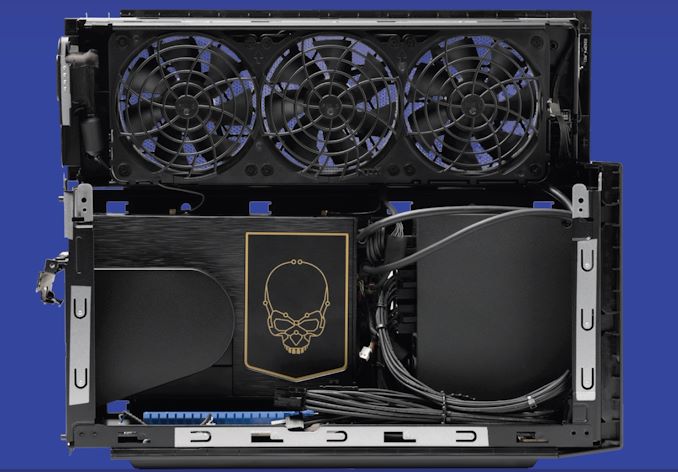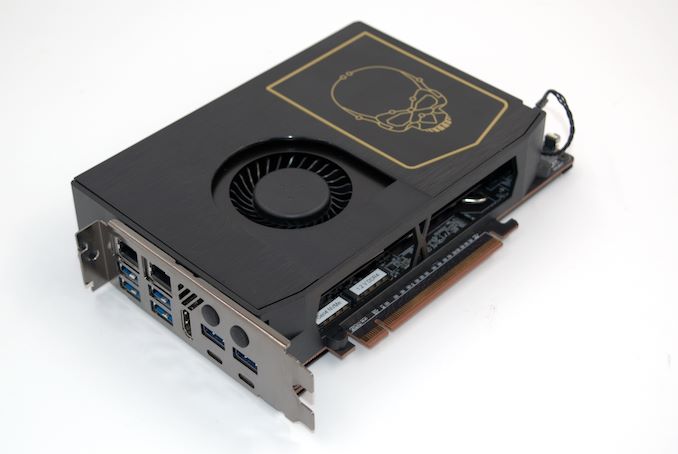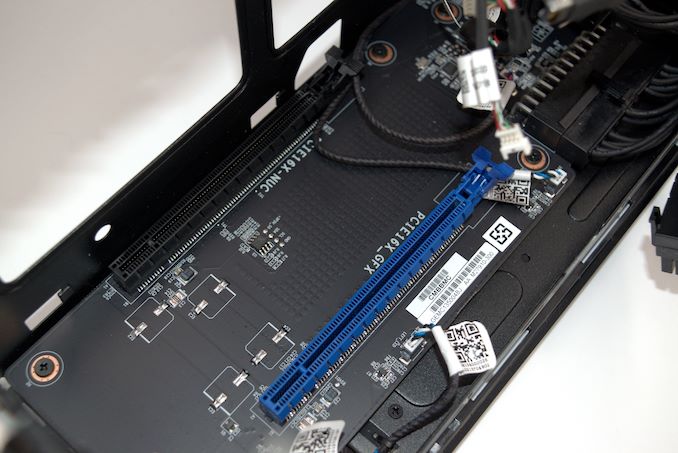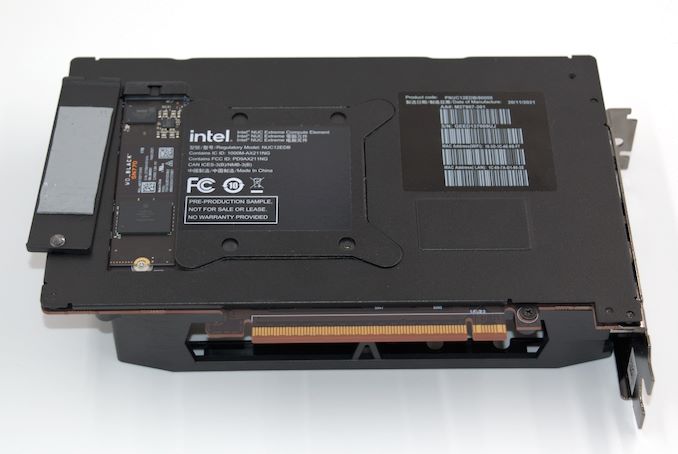The Intel NUC12 Extreme Dragon Canyon Preview: Desktop Alder Lake Impresses in SFF Avatar
by Ganesh T S on February 24, 2022 10:45 AM EST- Posted in
- Systems
- Intel
- NUC
- NUC12
- Dragon Canyon

Intel kick-started a form-factor revolution in the early 2010s with the introduction of the ultra-compact NUCs. The systems were meant to be an alternative to the tower desktops used in many applications where the size, shape, and the system capabilities were mostly unwarranted. The success of the NUCs enabled Intel to start reimagining the build of systems used in a wider range of settings.
More recently, the introduction of the Skull Canyon NUC in 2016 was Intel's first effort to make a gaming-focused SFF PC. And desktop-focused Compute Elements (essentially, a motherboard in a PCIe card form-factor) launched in early 2020 meant that full-blown gaming desktops could credibly come under the NUC banner. In the second half of 2020, the Ghost Canyon NUC9 – the first NUC Extreme – made a splash in the market with support for a user-replaceable discrete GPU. Ghost Canyon was extremely impressive, but the restrictions on the dGPU size and high-end pricing were dampeners. Intel made some amends with the NUC11 Extreme (Beast Canyon), using a special Tiger Lake SKU with a 65W TDP and comparatively competitive pricing.
The introduction of Alder Lake and its desktop-first focus has enabled Intel to prepare a new flagship in the NUC Extreme lineup barely 6 months after the launch of the Beast Canyon NUC. The new Dragon Canyon platform was briefly teased at the 2022 CES, with the promise of a Q1 launch. Intel is keeping up its word with the launch of a number of NUC12 Compute Elements and NUC12 Extreme Kit SKUs. Today, we are having a detailed look at what the NUC12 Extreme brings to the table, particularly in comparison to the NUC11 Extreme. The recent introduction of Windows 11 means that our benchmarks comparison set is currently limited - today's preview does not deal with any systems other than the NUC12 Extreme and NUC11 Extreme. A subsequent follow-up review will deal with gaming benchmarks (using dGPUs) and more comparison points with other SFF PCs in the market.
Introduction and Product Impressions
Intel's lineup of gaming-focused NUCs started with the Performance series (Skull Canyon NUC6i7KYK and Hades Canyon NUC8i7HVK), before moving up the ladder to the Extreme series (Ghost Canyon NUC9i9QNX). At the 2021 Computex, the Beast Canyon NUC took over the flagship mantle and brought about some important updates over the Ghost Canyon NUC:
- Support for 65W desktop-class CPUs in the Compute Element (compared to the 45W mobile workstation-focused CPU in the Ghost Canyon's Compute Elements)
- Increased chassis dimensions to accommodate larger discrete GPUs
- 10nm Tiger Lake CPU with new micro-architectural improvements for performance and power-efficiency
- Support for a richer set of I/Os (including PCIe Gen 4)
The teaser for the Dragon Canyon NUC at the 2022 CES brought in even more impressive features to the same form-factor - aspects that we are now able to confirm with a sample in hand:
- Support for 65W user-replaceable (socketed) desktop-class CPUs in the Compute Element (compared to the soldered CPU in the Beast Canyon's Compute Element)
- Alder Lake CPU manufactured in Intel 7 with new micro-architectural improvements for performance and power-efficiency, including hybrid performance and efficiency cores
- Support for faster I/Os (including PCIe Gen 5, PCIe 4.0 x8 equivalent bandwidth between the CPU and the PCH, and 10GbE wired networking support)
- Support for dual LAN ports (10GbE + 2.5GbE) in select SKUs, and better ports variety in the front - a Type-C and a Type-A USB 3.2 Gen 2 port instead of two Type-A ones in the Beast Canyon
A minor retrogression is the absence of support for PCIe lane bifurcation in the baseboard - while Beast Canyon's PCIe x16 dGPU slot could potentially be used in a x8 / x4 / x4 configuration, the Dragon Canyon's Edge Cove baseboard has no such support. The chassis still retains the M.2 22110 compartment on the underside, but there is no PCIe slot behind it.
Intel supplied us with an engineering sample of the high-end SKU in the Dragon Canyon line - the NUC12DCMi9 sporting the NUC12 Extreme Compute Element (NUC11EDBi9). This Compute Element is housed in a 357mm x 189mm x 120mm chassis - essentially the same one used in the NUC11 Extreme (Beast Canyon). Traditionally, NUCs have been associated with the ultra-compact form-factor (100mm x 100mm in a 0.63L or 0.42L chassis). The introduction of the Skull Canyon and subsequent Hades Canyon NUCs created yet another class of 0.7L to 1.2L NUCs, and the 2020 Ghost Canyon took it up to approximately 5L. The need to accommodate the cooling solution of a more powerful Compute Element, along with the ability to accept large dGPUs contribute to the 8L volume of the Beast Canyon and Dragon Canyon NUC chassis. This is still within the realm of SFF PCs - an adult can still single-handedly carry the unit around. Other important SFF aspects such as the in-built PSU are also carried over from the Beast Canyon NUC.
Intel's NUC lineup has traditionally included board and kit variants, allowing its partners to provide value additions (such as a passive chassis or additional I/O ports in the end system). Kits (other than the ones that come with a pre-installed OS) require the end-user to add storage, DRAM, and install an OS to complete the system. Intel plans to sell two varieties of the Dragon Canyon NUC Kit - the NUC12DCMi9 and the NUC12DCMi7. However, OEMs and end-users can also build their own NUC12 system based on the following components:
- Compute Element (NUC12EDBi9 or NUC12EDBi7 for the consumer market, and the vPro-capable NUC12EDBv9 or NUC12EDBv7 for the professional market)
- Baseboard (or backplane)
- Chassis
- PSU
- DRAM (up to 2x DDR4-3200 SODIMMs)
- Non-volatile storage
- Discrete GPU (optional)
An off-the-shelf Dragon Canyon NUC12DCM kit leaves only the DRAM, non-volatile storage, and discrete GPU to the choice of the end-user. Even though the Compute Element sports a LGA1700 socket, the two Compute Elements being sold in t he market come with the processor pre-installed (either Core i9-12900 or Core i7-12700). Prior to the platform analysis and overview of our review configuration, let's take a look at the pre-decided components in the above list.
NUC12 Compute Element
The NUC12DCMi9 we are reviewing today comes with the NUC12DEBi9 NUC12 Extreme Compute Element. It comes with a socketed processor - the Core i9-12900. This belongs to the Alder Lake (12th Generation) family, and has a 8C + 8c / 24T configuration with a 65W TDP. It can turbo up to 4.7 GHz. This Compute Element belongs to the series that started with the NUC9 generation, re-imagining the traditional motherboard in a discrete PCIe x16 card form-factor.
The Compute Element comes with a cooling shroud containing a single fan and three M.2 heat-sinks with thermal pads pre-attached. While two of those heat-sinks are in the side with the fan, the other is on the rear, behind the processor. The rear slot supports only M.2 2280 SSDs, and is connected directly to the processor. The two slots directly under the cooling shroud are PCH-connected ones. On the extreme right, we have the two SODIMM slots that can operate at speeds of up to DDR-3200 for DIMMs up to 64GB in total. These are vertical slots (compared to the horizontal ones in the NUC9 Compute Elements), and free up valuable space that gets taken up by the M.2 slots. It must be noted that the socketed processor requires slightly larger board estate - resulting in the movement of one of the three M.2 slots in the Driver Bay (Beast Canyon) Compute Element to the rear in the Dragon Canyon. The gallery below provides additional photographs of the Compute Element and the cooling shroud.
The NUC12DCMi9 comes with two Thunderbolt 4 ports, a 2.5G Ethernet port, a 10G Ethernet port, a HDMI 2.0b display output, and six USB 3.1 Gen 2 Type-A ports in the rear. There are two USB 3.2 Gen 2 ports (one Type-A and one Type-C), a 3.5mm stereo headset jack, and a SDXC slot with UHS-II support in the front. The front I/Os are enabled by a daughterboard that connects to the headers in the Compute Element. The Compute Element has its own power connection to the PSU.
Eden Cove Baseboard
The baseboard used in the Dragon Canyon (code name Eden Cove) is an evolutionary update to the Monster Cove board used in the Ghost Canyon.
The PCIe lanes are now Gen 5, but they drop the x8 / x4 / x4 bifurcation capabilities designed into the previous generation.
Chassis and PSU
The NUC12DCMi9 chassis has the same 'ease' of installation as the previous generation Extreme NUC. The dimensions allow the installation of dual slot GPUs up to 12" in length. The included 650W 80+ Gold internal PSU also supplies a 8-pin and a 2x6+2-pin connector for the GPU. The chassis can be disassembled by removing the four screws to dislodge the rear cover, and popping out the side panels.
The top panel with the three fans rests on a hinge. The embossed directions in the frame helpfully guide the user to open it up. This is essential to get access to the Compute Element and remove its shroud to install the RAM and storage.
Despite the plastic framing in the front panel, the metal-based construction in other areas gives the chassis a premium look and sturdy feel. The Beast Canyon NUC chassis also features customizable RGB underglow lighting, as well as a replaceable RGB front logo. While cable management is not an issue by itself, disassembling the NUC and reassembling is challenging because of the limited space between the PSU and the Compute Element. The myriad connections between the Compute Element and the daughterboard / front panel can't be easily kept separate from the PSU cables. Fortunately, most users only need to worry about the dGPU installation. The scope for trouble here again comes not from a cable management perspective - rather, the USB 3.2 Gen 2 header connection cables to the daughterboard tend to get loose and make the front port operate at USB 2.0 speeds. These issues existed in earlier NUC Extreme Kits also, but the absence of an update to the chassis design means that these issues remain unaddressed.
The front USB ports are recessed, and given their Type-A nature, figuring out the correct orientation to plug in the peripherals is a bit of a hit or miss. Certain keyboard / mice receivers can end up being completely inside the recess, making it challenging to remove them when the other USB slot is also occupied. The placement of the PSU AC receptacle on the top end of the chassis means that the heavy AC power cord could potentially create cable management issues. In both these aspects, the Ghost Canyon NUC chassis had a much better design.
The configuration of our review sample of the NUC12DCMi9 was completed with the following components:
- 2x Mushkin Redline 4S320NNNF32G for 64GB of DRAM
- 1x Western Digital WD_BLACK SN770 1TB M.2 2280 SSD
The presence of a desktop-class CPU in the system means that the Beast Canyon NUC should easily be able to support powerful GPUs - an aspect we will discuss in a future article. Today, we look at the Dragon Canyon NUC with the minimum required additional components. In the next section, we take a look at the full specifications of our configured review sample, followed by a detailed platform analysis along with some notes on our setup experience.





















38 Comments
View All Comments
thestryker - Thursday, February 24, 2022 - link
Thanks for the preview, and looking forward to the rest of the review. While looking to verify which chipset was used I noticed the link to specs in the article's specs table goes to the 11th, not 12th gen ark page.It's interesting to see some of the drawbacks of using the desktop platform over the laptop one. Of course end users could likely replace these CPUs with Raptor Lake which comes out later this year rather than having to replace the whole element card as would otherwise be the case. I'm also a big fan of them putting 10g on this one with overall minimal price increase.
Z690 is capable of bifurcation so I wonder what the reasoning for omitting it is.
Interu wa shinde iru - Friday, March 4, 2022 - link
so this is intel's new marketing strategy, take it to the forums!Dug - Friday, March 11, 2022 - link
There's no room would be my guess for no bifurcation.Operandi - Thursday, February 24, 2022 - link
This thing a cool idea in concept but is awful in execution.They are making their own 100% proprietary form factor and they can't beat legacy existing iTX solutions in a performance per volume comparison ahd have to use off the shelf notebook cooling solutions and just a bunch of random fans pushing hot air out of the chassis? If they have complete control over where components are going to placed and the size, shape of the form factor they can come up with something smarter than this.
I would like to see large passive heatsinks for the CPU, chipset and whatever else needs cooling on the 'compute board' and utilizing a front to back or top bottom (depending on how the case is designed / shaped) in a push - pull cooling configuration with large 92, 120, 140mm fans depending on use case. This is such a lazy, garbage design and a wasted potential for better form factor which the industry really needs.
lazarpandar - Thursday, February 24, 2022 - link
This is 100% my reaction. The whole removal of the motherboard is cool but the way they've implemented it offers zero benefit. What are we supposed to take away from this loldamianrobertjones - Thursday, February 24, 2022 - link
Cool. People will still buy it.My only annoyance is not knowing if you can use a 12th gen compute unit in the 9th gen chassis.
Operandi - Thursday, February 24, 2022 - link
Which people? The ones big into buying overpriced garbage? 'Cool' and good for them I guess.Samus - Friday, February 25, 2022 - link
Yeah...I see these things just FLYING off the shelves.lazarpandar - Friday, February 25, 2022 - link
What specifically did you think was cool about his postarashi - Saturday, February 26, 2022 - link
Probably the part where his employer's name appeared.